Sunday, June 13, 2021
Flag Day
Within the space of four and a half weeks every year, the United States of America has three national days the feature our National Colors prominently: Memorial Day, Flag Day, and the Fourth of July. Tomorrow, June 14, is Flag Day, so I thought I’d post a few notes about our flag in recognition.
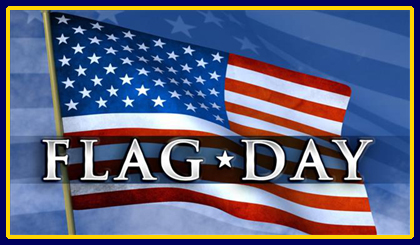
Flag Day was established in 1885, during a time when Americans were feeling overwhelmed by massive waves of European immigrants, which prompted strong feelings of nativism and nationalism. It wasn’t until 1916 that Flag Day was officially recognized, over which President Woodrow Wilson presided, although it has never been made a legal public national holiday. One state, however – Pennsylvania – made it a state holiday in 1937.
According to Marc Leepson in his book, Flag: An American Biography:
On August 3, 1949, Pres. Harry Truman signed into law a resolution passed by Congress designating June 14th of each year National Flag Day. That measure calls upon the president to issue an annual proclamation calling for a Flag Day observance and for the display of the flag on all federal government buildings. In 1966 Congress passed a Joint Resolution asking the president to issue an annual National Flag Week proclamation as well, and to call on American citizens to display the flag during the entire week in which June 14 falls.
The meanings of our flag’s elements – the colors red, white, and blue and the stars and stripes – are several. They are not trivial.
Here’s an excerpt about the colors from my own short story, “The Flag on the Great Man’s Breast,” for which I did considerable research. In the tale, a ghost flag tells the Lincoln story to a new flag raised above Lincoln’s tomb in Springfield, Illinois:
I was only so much pretty fabric. Like you, I was created to represent these United States of America and her ideals. I didn’t represent what is these United States, with its flaws and foibles of imperfect men; I represented the nation’s aspirations, the virtues we strive toward. Few achieve them.
The Great Man [Lincoln], however, was one of those who bring those ideals to life – he lived them, as near as a man can. He was my white stripes – white for purity, high ideals. He was my red stripes – red for hardiness, valor, courage, readiness to sacrifice. He was my blue canton, my spangled heaven – blue for vigilance, perseverance, justice.
The stars represent the number of states in the Union. The Second Continental Congress, convened during the American Revolution, passed the Flag Resolution of June 14, 1777 (hence, Flag Day’s calendar date), which states: “Resolved: that the flag of the United States be made of thirteen stripes, alternate red and white; that the union be thirteen stars, white in a blue field, representing a new Constellation.”
The stripes represent the original thirteen colonies who became a new nation, the white stripes meaning the separation from our mother country, England, represented by the red stripes.
The use of these colors was deliberate, to acknowledge our nation’s origins through Great Britain.
I hope these few tidbits might reveal to you some of the history and significance of our Star-Spangled Banner.
Sally M. Chetwynd
Brass Castle Arts
Email Me | Visit Website | Sign Up For Newsletter
To Tease Your Mind
The flag of the United States has not been created by
rhetorical sentences in declarations of independence
and in bills of rights. It has been created by the experience
of a great people, and nothing is written upon it that has
not been written by their life. It is the embodiment, not of
a sentiment, but of a history.

Woodrow Wilson
(1856-1924)
28th President of the United States
Abraham Lincoln on our Star-Spangled Banner
My husband has portrayed a first-person impression of President Abraham Lincoln since 1988, and it was in this role that he was asked, some years ago, to speak about the Stars and Stripes. We researched and wrote the following speech. We formed this text from Lincoln’s own words and from the book Flag: An American Biography (notes of which are featured below in the book section). We dated it April 14, 1865, Lincoln’s last day of life. Lincoln knew, would have known, or could have known the all of these details.
As we acknowledge our national standard today, I thought that you might be interested in some history with which I am personally familiar, regarding our Stars and Stripes.
Prior to the outbreak of this current conflict, our national flag was rarely displayed: primarily at military stations, at some government agencies, and frequently in political campaigns. My own presidential campaign used a flag imprinted with my image and that of my first vice-president, Hannibal Hamlin.
Upon my election in November of 1860, the ensuing unrest, North and South, stirred a national fervor around the flag. I could not be more pleased about the patriotic zeal which Americans now display toward the Stars and Stripes. The reason, however, deeply saddens me, for defending honor should not inspire one to bloodshed.
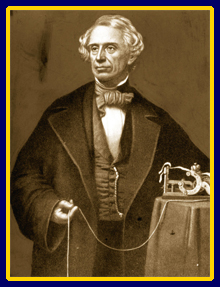
Poor old Samuel Morse. We can thank him for the advances in communications to the country with his invention of the telegraph, only 20 short years ago. But his political sentiment is not up to this struggle. He thought to retire in 1860, but with the fired-up rhetoric of the presidential campaign that year, he tried to turn his hand to diplomacy. He suggested a convention of states – a new national convention – in order to resolve their differences. I heartily supported that idea, and tried to arrange just that sort of meeting with Southern leaders, but without success.
I did not agree with Morse’s alternative, however. If the national convention failed to resolve anything, Morse proposed that the Union let the Southern states go, to become a separate nation, retaining friendly relations with the remaining Union. He even proposed that the United States flag be cut diagonally in half, with the stars divided and with six and a half stripes for each half. Each nation, North and South, would hold one of the halves.
His idea was that if a foreign nation threatened one or both of the two new nations, they would band together as allies, stitching together their flag halves, and fight for their common defense under the united flag.
Morse called this a “secession flag” or “peace flag.” The idea not only found little favor with anyone, North or South, but provoked some violent reactions. The newspapers reported in April of 1861 that a man from Massachusetts who flew one from his home was tarred and feathered by his neighbors.
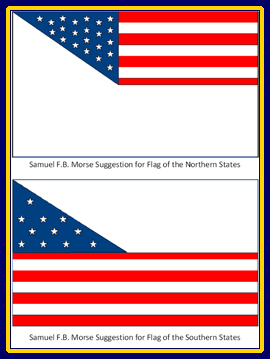
Upon the secession of the Southern states, many people in the North cut away eleven stars from their flags in protest. Even Congress proposed to remove the stars officially. I stood against these sentiments, for I firmly believe two things:
- that our Southern brethren cannot by law remove themselves from our Union, and
- that to remove those stars from our flag would acknowledge that those states had become a separate government, a new nation. This administration could never recognize the South as a separate nation; to do so would undermine what our founders fought so hard to give us, as well as what so many young men have fought for – our Union. We cannot recognize that which we deny.
As part of my inaugural journey from Springfield, Illinois, in February 1861, I was privileged to participate in an early-morning flag-raising ceremony in Philadelphia, at Independence Hall. The date was February 22, Washington’s birthday. The crowd was huge, and their voices thundered with approval as I personally raised an American flag, a new one emblazoned with 34 stars, to include Kansas, which was admitted to the Union only three weeks earlier.

Later that day, when we had continued to Harrisburg, Pennsylvania, my remarks included the statement that, during that deeply moving event that morning, “I could not help hoping that there was, in the entire success of that beautiful ceremony, at least something of an omen of what is to come … The flag of our country may yet be kept flaunting gloriously.”
Once South Carolina fired upon Fort Sumter in Charleston Harbor on April 12, 1861, an intense patriotism consumed the land. The lowering of the Stars and Stripes two days later on April 14, when Major Robert Anderson removed our troops from the fort, precipitated the raising of the flag in the North – thousands of towns and homes blossomed with banners. The defense of the flag and what it stands for served as a unifying force for the oncoming war. The New York World called it “flag mania” a week after Fort Sumter surrendered. Everyone gave a speech, including my old friend and political rival Stephen Douglas, who spoke before the joint session of the Illinois legislature, imploring us all to preserve the flag, and calling us to rally under it.
A year later, Mr. George Root supported my July 2nd call for 300,000 more volunteers, by writing and publishing his song “Rally ’Round The Flag” also known as “The Battle Cry of Freedom.” It has served as a valuable recruiting tool.
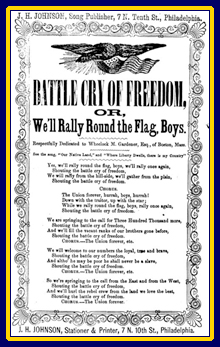
A particularly sad note for me regarding the flag was the death of Colonel Elmer Ellsworth about a month after the outbreak of war. He was a young law clerk who had worked in my office in Springfield, and accompanied me to Washington. He recruited the 11th New York Volunteer Infantry Regiment, the “Fire Zouaves.” On May 24, 1861, when he spied a rebel flag flying from an inn across the Potomac River in Alexandria, Virginia, within view of the Executive Mansion, he resolved to remove it. The innkeeper killed him as Ellsworth, with the rebel colors in his arms, descended from the roof. Ellsworth’s soldiers brought the banner back to the Executive Mansion, where my wife Mary hid it away. She did not hide it well enough, however, for our young son Tad has often discovered it and pulled it out to wave at well-wishers who often assemble on the lawn here.
As much as our family, and the nation, mourned for young Ellsworth, who was the first commissioned officer killed in this conflict, I was gratified to learn a little later, when our National Colors were once again hoisted over the City of Alexandria, that many of the residents wept for joy to see once again this familiar and much-loved emblem.
All during this war, the flag and the passion surrounding it have generated songs, poems, stories, and slogans. Booksellers often find themselves sold out of patriotic envelopes and stationery with printed images of the flag. Nearly every Union soldier has a Bible flag – small enough to tuck into his New Testament – which he carries in his haversack or breast pocket.
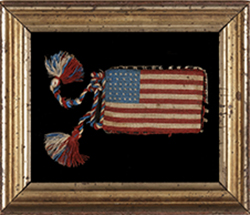
Seeing the war’s end in sight late during this last winter, I signed into law on March 2, only 6 weeks ago, a measure which requires our federal government to purchase bunting and flags only from American manufacturers, to foster a continuing interest in the honor of our flag. Until this law, we have been importing woolen bunting almost entirely from England. To meet this new demand, General Benjamin Butler founded the United States Bunting Company in Lowell, Massachusetts, and earlier this week, he presented me with the company’s first flag, one with 37 stars, which anticipates Nebraska’s upcoming entry into the Union.
The war has raged for four long years, but with Lee’s surrender this past week, we have good reason to believe that the outlying bands of resistance will lay down their arms and submit to the Union. Even as I speak today, Major Anderson is once again raising our beloved Stars and Stripes over the battered remains of Fort Sumter in South Carolina, restoring federal authority within that state. I’ve sent one of my secretaries, John Nicolay, to represent this administration at that ceremony.
I hope you will join me in saluting our National Colors today, and remembering the soldiers, sailors, and citizen patriots who have given their all under this banner, that we may stand here today in freedom. Thank you.
A Book Worth Checking Out
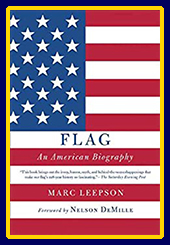 Flag: An American Biography
Flag: An American Biography
Marc Leepson
Thomas Dunne Books, an imprint of St. Martin’s Press (2005)
[abridged book notes from Amazon]
The thirteen-stripe, fifty-star flag is as familiar an American icon as any that has existed in the nation’s history. It stirs something in the hearts of Americans like no other symbol. Yet the history of the flag, especially its origins, is cloaked in myth and misinformation. Flag: An American Biography rectifies that situation by presenting a lively, comprehensive, illuminating look at the history of the American flag from its beginnings to today.
Journalist, historian, and author of the highly acclaimed Saving Monticello, Leepson … traces the evolution of the American flag from the Colonial period to its prominent role as a symbol of American resolve in today’s war against terrorism.
…
Leepson analyzes the influence and impact of the maker of the star-spangled banner, Mary Pickersgill; the author of the national anthem, Francis Scott Key; the coiner of the phrase “Old Glory,” U.S. Navy Capt. Samuel Driver; the first officer killed in the Civil War, Union Col. Elmer Ellsworth, who died defending the flag; the first African-American Medal of Honor recipient, William Carney, who carried the flag and led troops through a viciously bloody Civil War battle; the creator of Flag Day, Wisconsin schoolteacher B. J. Cigrand; the father of the pledge of allegiance, Francis Bellamy; and Joe Rosenthal, the AP photographer who took the most reproduced image of the twentieth century, the Marines raising the American flag at Iwo Jima.
…
“Flag,” as the novelist Nelson DeMille says in his preface, “is not a book with an agenda or a subjective point of view. It is an objective history of the American flag, well researched, well presented, easy to read and understand, and very informative and entertaining.”
Calendar & Announcements
Saturday, July 10, 2021
Scituate Farmers Market
9:00 am – 12 noon
Institute Lane, Scituate, RI 02857
(Last month I posted the Scituate Farmers Market for Scituate, MA., which was wrong. The Scituate Farmers Market where I’ll be exhibiting my books is in Scituate, RI.)
Saturday, December 11, 2021
Association of Rhode Island Authors (ARIA) Author Expo
10:00 am – 4:30 pm
Rhodes on the Pawtuxet
60 Rhodes Place, Cranston, RI 02905
Conversations
These newsletters do sometimes generate conversations with my readers. There is often a lesson to be learned, on one end or the other. It’s all good. Here’s a bit of conversation from the last newsletter.
In the book notes about The Editor’s Companion, I wrote, “No matter how good a writer or editor one is, mistakes will happen or slip by unnoticed.” Well, er, that’s not quite what I wrote. My friend Ellen pointed out that the word “matter” was missing its “r” – “No matte how good …” I could have tried to make a joke about it by insisting I had deliberately left it off to see if anyone noticed, but that wouldn’t have been the truth. Instead, I laughed at myself and replied that this is what keeps one humble!
Do you have comments or questions about this post? I’d love to hear them. Let’s talk!
Happy reading! Happy writing!
Sally
Sources
Image: Flag Day
https://www.andoverma.us/746/Flag-Day
Smithsonian Institution: Facts about the United States Flag
https://www.si.edu/spotlight/flag-day/flag-facts
Library of Congress: Flag Day
https://www.loc.gov/item/today-in-history/june-14/
Image: Wikipedia: Woodrow Wilson
https://en.wikipedia.org/wiki/Fourteen_Points
Image: Samuel Morse with his telegraph machine, c. 1857
http://oldintranet.puhinui.school.nz/Topics/Communication/Morse/MorseHistory.htm
Image: Samuel Morse’s “Peace Flag” of 1861
https://flag-post.com/lincoln-refused-to-remove-stars-from-the-u-s-flag/
Images: Lincoln raises 34-star flag over Independence Hall, March 9, 1861
https://flag-post.com/lincoln-refused-to-remove-stars-from-the-u-s-flag/
Image: Rally Round the Flag
https://civilwarfolkmusic.com/2012/08/22/1862-battle-cry-of-freedom-root/
Image: Bible flag
https://jeffbridgman.com/inventory/index.php?page=out&id=3983
Image & book blurb: Marc Leepson’s book
Flag: An American Biography
https://www.amazon.com/dp/B003J4VEMW/ref=dp-kindle-redirect?_encoding=UTF8&btkr=1



